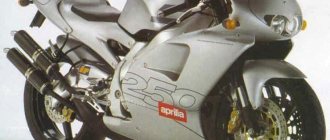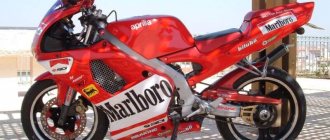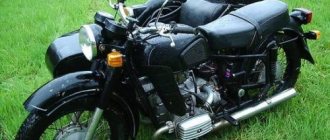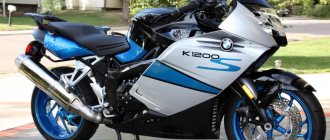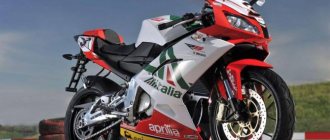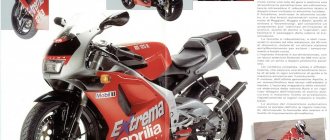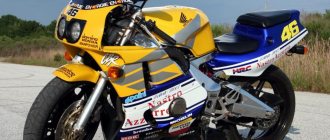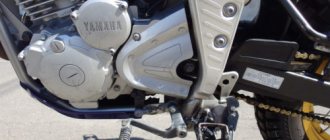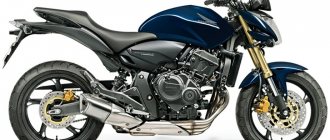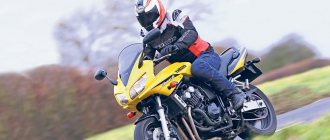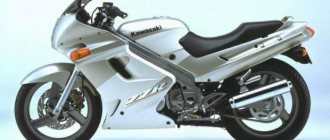Sportbike Aprilia Shiver SL 750 (2008)
Without any doubt, the Italians are specialists in V-twin engines. And Aprilia motorcycles are motorcycles to be reckoned with on the road. And in the spring of 2008, Aprilla introduced a new entry-level sportbike, the Aprilia Shiver 750, “awe-inspiring” (translated from English as “Shiver”). We can immediately say that the Aprilia Shiver is equipped with good suspension, excellent brakes and provides good driver comfort.
But the small volume of the fuel tank and the lack of choice of colors are not arguments in favor of the new Aprilia Shiver 750... but let’s not draw quick conclusions and let’s look into everything in more detail...
Name, appearance and essence of Aprilia Shiver 750.
And the name and appearance of the Aprilia Shiver 750 are “pretentious.” Firstly, “Shiver” is translated as “trembling” or “trembling”. And this name goes very well with the aggressive appearance of the sportbike. Even despite the impossibility of choosing colors, the motorcycle looks more than impressive. And, the aggressive metallic color of the motorcycle, combined with a transformers-style design, can really inspire awe and make opponents tremble in the knees... and attract the attention of female representatives (as Aprilia advertising motifs hint).
The Aprilia Shiver 750 is a mid-size naked sports bike for the entry level.
Aprilia's latest engine, the Shiver 750, is a liquid-cooled, 90-degree V-twin four-cylinder engine with two spark plugs per cylinder. The engine is capable of developing 95 hp. at 9000 rpm. and torque 8.25 kg/m at 7000 rpm. Due to the need to meet EURO-2 emissions requirements, as well as to provide tuning flexibility, the Aprilia Shiver engine is equipped with an injection system and twin Ride-by-Wire throttle bodies. In general, the latest and sophisticated electronic control of the Aprilia Shiver 750 sets new standards for naked motorcycles. For example, the use of Ride-by-Wire technology, for the first time in the motorcycle industry, has become part of standard equipment. And the electronic accelerator control of the Aprilia Shiver 750 optimizes the opening of the throttle valves according to numerous parameters, including engine speed, current gear and throttle position. Therefore, the Aprilia Shiver 750 engine is always able to provide optimal acceleration performance combined with low fuel consumption. These and many other innovative solutions used in the Aprilia Shiver 750 guarantee an even more complete and correct delivery of torque at low and medium speeds, optimizing acceleration.
The Aprilia Shiver 750's ultra-compact engine is neatly housed in a modular frame with two die-cast aluminum rear sections and a trellis-like tubular steel front section. The swingarm pivots in aluminum sections, with the right section forming the front mount for the Sachs single shock, which is adjustable for preload and rebound. The Aprilia Shiver shock absorber is complemented by a non-adjustable inverted fork. The impressive Aprilia Shiver 750 radial brakes are actually a copy of the Taiwanese Brembo with dual 320mm floating discs. At the rear there is a regular 245 mm disc and a two-cylinder caliper.
As we have already noted, the Aprilia Shiver 750 stands out with the so-called “transformers” style, which is most noticeable in the example of the Suzuki B-King. What can we say - the styling is good, looks impressive and especially suits the class. But the opportunity to choose from at least a couple of colors would be very useful.
Test drive Aprilia Shiver SL 750.
If you forget for a while about the appearance of the Aprilia Shiver 750 (some people like it, but others don’t), and focus on how this motorcycle behaves on the road, then it becomes clear “without any buts” that the Aprilia Shiver The 750 demonstrates amazing handling... and in general completely justifies and characterizes (only on the positive side) the great work that Aprilia engineers did in creating the Aprilia Shiver 750. The engine capacity is 750 cc. cm for Aprilia Shiver is not a problem. Of course, it doesn’t have the same low-end power as motorcycles with engines a liter larger in volume, but, to be honest, the Aprilia Shiver 750 doesn’t need it.
All you have to do is release the clutch for a “sharp start from a traffic light” and, in the first two gears, the front wheel of the Aprilia Shiver 750 lifts off the ground. For a more relaxed ride, the Aprilia Shiver 750's engine is responsive and smooth, making it easy to get around town. By the way, in the city, in fact, regardless of the full power of the motorcycle, in 90% of cases you will need only 50
85 hp, and how you use this power will determine whether you go really fast or achieve nothing. On the Aprilia Shiver 750, the tachometer can be cranked up to 9000 rpm. Despite the fact that real pickup is achieved already at 6000 rpm, and at the same time, gears are changed very easily. But “in close combat” (on winding village roads), when it is especially necessary to balance speed and grip, the Aprilia Shiver 750 is unlikely to be a winner.
I would like to note the vertical position of the driver (as on superbikes) ... it’s a pity that the small volume of the fuel tank (15 liters) is not at all conducive to long trips.
The steering of the Aprilia Shiver 750 is light and the geometry of the motorcycle combines equal parts agility, responsiveness and even forgives the driver for minor mistakes.
Aprilia Shiver 750 - premium mid-volume naked
Italian manufacturers are valued primarily for their particularly bright and high-quality motorcycles, but few people have thought about the fact that both Ducati and Aprilia simply shoot rarely, but accurately, focusing and working on each model to the maximum, from marketing market research to promotion and after-sales service .
The Aprilia model range can be counted on one hand, and yet each motorcycle is unique and claims to be something. As for the Aprilia Shiver, these motorcycles have the right to count on the optimal price-quality ratio in the category of premium mid-volume naked bikes. If it weren’t for this motorcycle: Ducati Monster 796, then the Aprilia Shiver 750 would have the right to leave a claim for leadership, however, being inferior to it in “fatness”, the Shiver wins in price. Let's take a closer look at Shifer. First presented to the public in 2008, the motorcycle attracted attention with its technical potential. V-shaped four-stroke twin engine with a volume of 749.9 cm³ on 2 cylinders with a camber angle of 90 degrees and with liquid cooling, developing a peak power of 95 hp. at 9,000 rpm - this was exactly what Aprilia can do, and there was no doubt about it. Ride-by-Wire technology as standard - electronic accelerator control, adjusted to many driving parameters (engine speed, current gear, etc.), is responsible for optimal acceleration in any situation and for minimal fuel consumption. At the same time, the engine turned out to be more than just modest in size.
The motorcycle's engine is housed in a modular frame with a cast aluminum rear swingarm. The rear sections of the frame are also made of aluminum, but the front section is steel. There were no complaints about the frame - it copes with its tasks quite well. As for the suspensions, in the basic configuration the front fork will not be adjustable, and the rear monoshock absorber is adjustable only for preload, but the suspension is configured from the factory in such a way that there is no need to adjust it.
Aprilia
It’s not even clear what could be improved on the Shiver 750 motorcycle, but the engineers had to come up with something to call the 2010 model even more advanced.
That's what they did, the 2010 motard received a new fairing around the headlight, brake discs and livery. The engine and chassis remained the same. Aprilia's press release states the following:
“The evolution of the Shiver project has no boundaries. The open motorcycle, which surprises everyone with its technological content that is beyond the reach of competitors, has become even more sophisticated and individual.
It is clear that the Aprilia Shiver 2010 is a reference motorcycle in its category. The high-tech engine uses the latest generation “Ride by Wire” technology. Several modes can satisfy the pilot's every whim.
The Aprilia Shiver is a much more exciting motorcycle for 2010, updated with new fairing and brake discs. The motorcycle as a whole has become more sporty and aggressive. The saddle is made 5cm narrower for better control and optimized handling."
Technical characteristics of Aprilia Shiver 750 2010:
• Engine: Aprilia V90, four-stroke, V-Twin, liquid-cooled, mixed camshaft drive, four valves per cylinder, Euro 3 • Fuel: unleaded gasoline. • Bore x Stroke: 92 x 56.4 mm • Volume: 749.9 cc • Compression Ratio: 11:1 • Max Power: 95 HP at 9000 rpm • Maximum torque: 8.25 kgM at 7000 rpm • Fuel system: injector • Ignition: digital, electronic • Start: electric • Exhaust: 2 in 1 • Generator: 450 W at 6000 rpm • Lubrication : wet sump • Gearbox: six speeds • Clutch: multi-plate in oil bath, hydraulically controlled • Prime mover: spur gear, gear ratio - 60/31 (1.75) • Final drive: chain (16/44) • Frame: modular, combination of steel and aluminum components • Front suspension: 43 mm inverted fork, 120 mm travel • Rear suspension: aluminum swingarm, hydraulic shock absorber, 130 mm travel • Front brake: 2x320 mm discs, four-piston caliper • Rear brake: 240 mm disc, caliper with 1 piston • Wheels: 3.50 X 17″ and 6.00 X 17″ • Tires: 120/70 ZR 17 and 180/55 ZR 17 • Overall length: 2265 mm • Overall width: 800 mm • Overall height: 1135 mm • Seat height: 810 mm • Wheelbase: 1440 mm • Trail: 109 mm • Rake: 25.7° • Dry weight: 189 kg • Fuel tank capacity: 16 l
Aprilia Shiver 750 – premium mid-volume naked
Italian manufacturers are valued primarily for their particularly bright and high-quality motorcycles, but few people have thought about the fact that both Ducati and Aprilia simply shoot rarely, but accurately, focusing and working on each model to the maximum, from marketing market research to promotion and after-sales service .
The Aprilia model range can be counted on one hand, and yet each motorcycle is unique and claims to be something. As for the Aprilia Shiver, these motorcycles have the right to count on the optimal price-quality ratio in the category of premium mid-volume naked bikes. If it were not for this motorcycle: Ducati Monster 796, then the Aprilia Shiver 750 would have the right to leave a claim for leadership, however, being inferior to it in “fatness”, the Shiver wins in price. Let's take a closer look at Shifer. First presented to the public in 2008, the motorcycle attracted attention with its technical potential. V-shaped four-stroke twin engine with a volume of 749.9 cm³ on 2 cylinders with a camber angle of 90 degrees and with liquid cooling, developing a peak power of 95 hp. at 9,000 rpm – this was exactly what Aprilia knows how to do, and there was no doubt about it. Ride-by-Wire technology as standard - electronic accelerator control, adjusted to many driving parameters (engine speed, current gear, etc.), is responsible for optimal acceleration in any situation and for minimal fuel consumption. At the same time, the engine turned out to be more than just modest in size.
The motorcycle's engine is housed in a modular frame with a cast aluminum rear swingarm. The rear sections of the frame are also made of aluminum, but the front section is steel. There were no complaints about the frame – it copes with its tasks quite well. As for the suspensions, in the basic configuration the front fork will not be adjustable, and the rear monoshock absorber is adjustable only for preload, but the suspension is configured from the factory in such a way that there is no need to adjust it.
As for the brakes, they are of our own production, although they are similar to the famous Brembo. They easily stop the motorcycle from any speed and could easily be used on a liter. At the same time, their own production made them much cheaper. Overall, the handling of the motorcycle is excellent. As for design, is it worth reminding that it is the Italians who are the trendsetters in the motorcycle industry?
Since 2009, this motorcycle has been produced in two versions:
- Aprilia shiver SL 750 – naked as standard
- Aprilia Shiver 750 GT - version tailored for tourists (advanced panel with additional sensors, improved fairing, 3 engine operating modes, ABS, etc.)
Many argue that the PE version is much more attractive compared to the basic one, but these motorcycles simply have slightly different purposes.
You can buy a new Aprilia Shiver 750 in Europe from $13,000.
But as practical as Shiver is, it just didn't captivate me.
I recently spent some time with the 2011 Shiver (same as the European 2010 model, but without ABS) and came away impressed with the modified bike. Hair and makeup please! Although the latest SL750 hasn't received comprehensive changes since the 2008/2009 versions, what improvements have been made are the result of Shiver user feedback analyzed by Aprilia.
A narrow saddle, new windshield, rear handlebars and rear-mounted footpegs are designed to give the bike a sportier appearance, while sculpted brake pads, a narrower (5.5-inch instead of 6.0-inch) rear wheel and improved fuel delivery complement the technical improvements.
It should be noted that the ergonomic design is adjustable, which is the most noticeable improvement over Shiver's first model, but to be fair, it's hard to find a problem with the old sizes and therefore impossible to say whether the new changes are beneficial.
A really nice addition was the well-colored windshield.
It doesn't envelop the rider in a cocoon of still air, but it does help soften some of the airflow compared to older models. To be honest, the previous, completely naked Shiver models (although they were no more than a year old) were protected from gusts of wind only by the shape of the headlights.
Perhaps I paid too little attention to the Shiver 1.0, but just taking a look at the 2011 model, I was amazed at how much I hadn't noticed the first time. How could I forget such a fun, grunting and ferocious 750cc V-Twin engine?
Although there are no changes described in the liquid cooling system, four-valve cylinders, gas distribution mechanism, 479cc engine displacement, 90-degree Twin engine, but it made a completely different impression on me this time. By "totally different" I mean it's pretty fun to hit the throttle open, blow through the pinch valve, and try to hold the outer part. Equally consistent is the smelly, exhaust gas under the tail, but again, I guess I have to remember that such a burly noisemaker creates a neat popping and burbling sound on overdrive once you slam the throttle down from a higher frequency.
Despite my damaged memory, I still know that the Shiver features a three-mode layout and that while Sport mode gives the rider full power, it is also quite harsh when the throttle is applied again. Interestingly, this small glitch remains even in light of the improved positioning system, which has an otherwise smooth response to gas and fuel supply since the previous model. The solution to the jerky fuel delivery in Sport mode is to switch to Travel mode, which still delivers peak power, but in smoother bursts. And the rain mode, which, of course, is also present, significantly reduces the power in the same way as it did before.
The only thing I would like to see removed from the mode change procedure is the need to completely turn off the ignition before the modes change.
When driving interstate (or anywhere for that matter), I didn't bother slowing down to wait for the modes to change, and then turning on the ignition to reach the same speed. Ultimately, I don't think there's a drop in power between modes enough for the Shiver to suddenly rear up, neigh, and throw an unsuspecting rider off. This is not a lyrical digression in any sense, just an opinion.
In the spirited period, the 2011 Shiver produces 73 horsepower at 8,800 rpm, compared to Ducati's latest air-cooled, two-valve Monster 796, which produces 76 horsepower at 8,400 rpm when both models were tested. However, the Shiver's peak torque output of 60.0627 Newtons per meter at 7600 rpm is clearly surpassed by the 796's grumbling 71.8584 Newtons per meter at 6400 rpm. The new brake pad style brings a more modern, if not trendy, look to the Shiver, but may also improve braking performance in some way. I remind you that Aprilia's previous famous braking system, radial-mount calipers and stainless steel braided cables, stopped the bike forcefully, perhaps even too abruptly, as Kevin pointed out in his 2008 Shiver review. But I even want to remind you about the feeling of the brake, or rather, about its insufficiency. According to Aprilia, the pad panel material remains the same, but although it may just be my imagination, some improvements are felt. Adjusting the multi-point reach of the brake and clutch levers is quite convenient, but reaching any lever is quite long, even if set to the suggested positions with the least reach. Standard positions require fairly long arms to reach the full distance to hold, so it's a good idea to think about safety and have girls who like Shivers consider aftermarket swapping out the arms for ones with a higher range or a different range of adjustment.
The frame's steel tube trellis, bolted to aluminum side plates, remains the same as before, as does the non-adjustable 43mm fork and decoupled shock damping system that allows for spring conditioning and gradual damping.
For these parts we tend to favor the more progressive and linear actions offered by impact systems. But at least access to the Shiver's built-in shock absorption system is extremely easy compared to most motorcycles. And we have to think that the suggestion of at least prepping the spring for the front end looks like what was required for a sporty bike like the Shiver.
According to Josh Kane, maintenance manager for Piaggio's testing and technical center in Costa Mesa, California, a couple of simple adjustments to the Shiver's suspension will ensure the Shiver's already excellent handling continues.
Increasing the number of Shiver fork tubes to the two lines specified above the triple clamp (the base configuration does not specify a single line), and adjusting the shock spring preparation to 27.5mm coils (the basic configuration is 9.7mm) follows eight recoil latches (from fully closed) instead of the basic settings of 11 - this is the path to the best possible steering response and overall handling.
The 180/55-17 rear tire size remains from the previous generation Shiver, but the new Shiver's half-inch narrow rear tires create improved triangulation in the tire profile, better matching the profile of the front tires, and this is a key factor in improving the response and handling qualities in the new Shiver.
The chassis provides superb direct response, making the tracking behavior of this Italian machine more predictable time after time. A set of grippy Pirelli Diablo Corsa III tires will keep you glued to the pavement. While it wasn't a particularly comprehensive overhaul, Shiver received a number of useful improvements in 2010/11. But, the one thing that has remained the same between the first Shiver and the last and greatest Shiver is the manufacturer's price - $8,999. The Shiver doesn't compare to the Monster 796 in the engine performance comparison arena, but to get the extra 13.56 Newtons per meter from the Ducati, you'll have to pay another $600 on top of the Shiver's price to get the base Monster model.
When you consider the Shiver's offerings of switchable distribution, greater verticality, everyday ergonomics, and overall performance comparable to the 796, you may find a fairly small price gap, more significant than it might seem at first glance. My current newfound familiarity with the improved Shiver makes me think I'd consider the Shiver twice if I were you.
SL 750 Shiver
Aprilia Shiver 750 (SL750) is a powerful streetfighter that embodies advanced technology and the highest performance, contained in a fashionable “packaging” from leading Italian designers.
The Shiver 750 combined trellis frame houses a V-shaped power unit with a displacement of 750 cubic centimeters, producing a maximum of 95 horsepower at 9000 rpm and 81 Hm of torque at 7000 rpm.
The amazing driving performance of the Shiver 750 is guaranteed by a 32 mm inverted fork at the front, as well as a rear monoshock absorber offset relative to the longitudinal axis of the bike with a cantilever mounting to the pendulum.
The Shiver 750 borrows 320 mm floating front brake discs from its sports brothers Tuono 1000R and RSV 1000 R. They are equipped with proprietary radial 2-piston calipers. At the rear, the motorcycle is equipped with a single disc with a diameter of 245 millimeters with a floating 1-piston caliper. Also, depending on the modification, the factory equipment may include an ABS anti-lock braking system.
To spite all the “Japanese”
To spite all the “Japanese”
Well, you know: Aprilia was almost killed by 50cc scooters. The moment came when the market for “fifty kopecks” was shredding, the company’s small “stools” began to sell less and less, profits decreased, and the company was saved from death and oblivion only at the cost of losing its independence - it was sold to the Italian concern Piaggio. The new owners wondered: why in the production program there is nothing similar to what brings good profits - the bestsellers Honda 600 Hornet, Yamaha FZ6 Fazer and Kawasaki Z750* The fruit of thought in front of us is the mid-range roadster Aprilia Shiver SL750. In the near future, expect this machine to become the founder of a whole family of motorcycles for various purposes and displacement, from 750 to 1200 cc.
The new bike has nothing to do with the RSV750 prototype created at the end of the last century - a smaller version of the 1000 cc sports bike (with a V-twin with a camber angle of 60°). Nothing but the name connects it with the Shiver concept bike - the machine in which the RSV1000 engine was first installed 12 years ago. In fact, the SL750 twin (with a camber angle of 90°) is the first-born of a new family of engines developed at the Piaggio technical center under the direction of engineer Lucio Masuta. Its distant prototype is the same 1000 cc twin that was installed in the Gilera chassis at the turn of the century.
. I remember a meeting I had with Piaggio's chief executive, Signor Rocco Sabelli, in February 2005, shortly after Aprilia changed hands. My interlocutor said he was shocked that the company did not even try to create a competitor to such popular bikes as the Ducati Monster and Honda Hornet 600: “They told me that it would take, you see, two and a half years to develop such a motorcycle. I answered: well, then why hesitate - start! If you want to be perceived as a respectable world-class motorcycle manufacturer, start producing mid-range bikes - you can't do without them! And give up foreign engines (RSV1000 series engines are made at the Austrian Rotax plant - author's note). The Piaggio engineering center has enough smart designers and high-quality equipment to develop engines of any size and produce up to half a million power units a year.”
Sabelli did not waste words. The Aprilia Shiver SL750 entered the Italian market in July, priced around 8,000 euros. This is 10% more expensive than 4-cylinder Japanese motorcycle competitors - well, its technical level is higher. Judge for yourself: there are radial caliper brakes, adjustable levers, a hydraulic clutch, spark plug caps with built-in coils, an electronic instrument panel, and drive-by-wire throttle control. On cars, such a “lotion” has already become commonplace, but in the world of motorcycles it is so far only in MotoGP technology. Yamaha, on the R6 model, used it for the first time on a production motorcycle, but only halfway: the electronic unit calculates how much to open the throttle valves, but ordinary springs close them. On Shiver, the flaps open and close under electronic control.
